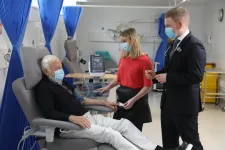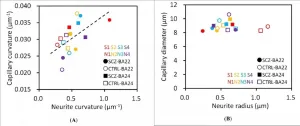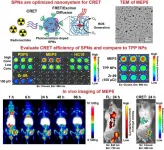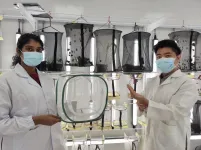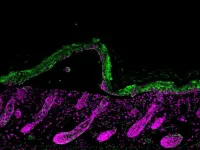(Press-News.org) Some 42% of patients attending a dedicated diabetes clinic have signs of established chronic kidney disease, the first detailed research of its kind in Ireland has revealed.
The study was carried out by academics at NUI Galway and clinicians at University Hospital Galway Diabetes Centre and involved more than 4,500 patients in the west of Ireland.
The findings suggest that, despite careful medical management, a relatively high proportion of people with diabetes in Ireland are developing chronic kidney disease over time and are at risk of kidney failure and other complications of poor kidney function.
Diabetes is now the number one cause of chronic kidney disease and kidney failure worldwide.
At least one in 15 people in Ireland has diabetes, three quarters of whom are adults with type 2 diabetes.
Professor Matthew Griffin, consultant nephrologist at Galway University Hospitals and researcher in NUI Galway's College of Medicine, Nursing and Health Sciences, said: "When evidence of chronic kidney disease due to diabetes appears, it usually indicates damage to the kidneys that cannot be reversed and may well worsen over time."
The research, published in the journal BMJ Open Diabetes Research and Care, is the first comprehensive analysis of the overall burden of chronic kidney disease among people with diabetes in Ireland.
It found that:
42% of patients at the clinic had evidence of abnormal kidney function, based on the results of commonly-performed blood and urine tests.
The rate of chronic kidney disease among diabetes patients is more frequent than previously recognised.
The frequency of chronic kidney disease was higher - almost 50% - in those with type 2 diabetes.
The kidney function of more than one quarter of all the patients and nearly one third of those with type 2 diabetes was declining at a faster rate than expected.
The research team said the findings of the prevalence and rate of chronic kidney disease were particularly concerning because the number of people affected by type 2 diabetes is increasing steadily around the world. In the next 20 years it is expected to reach close to 700 million people.
Dr Tomás Griffin, consultant endocrinologist specialising in diabetes care at Galway University Hospitals, Honorary Senior Lecturer at NUI Galway and lead researcher on the study, said: "The findings tell us that adults living with diabetes in Ireland have rates of chronic kidney disease and rapid decline in kidney function that are comparable to, or greater than, populations which have been studied in the UK, other European countries, the US and Asia.
"The study provides important information for people with diabetes because new treatments and interventions are emerging which may offer better protection of kidney function over time when introduced in the early stages of chronic kidney disease."
Professor Griffin added: "Worryingly, many people with diabetes are unaware of the earliest evidence of diabetic kidney disease that can be identified in their blood and urine tests. This research shines a light on the need for greater awareness of these tests during the early stages of diabetes management and more collaborative care by diabetes and kidney specialists."
Professor Francis Finucane, co-author on the study and consultant endocrinologist specialising in the management of obesity and diabetes at Galway University Hospitals, said: "The more we can do to prevent type 2 diabetes and the factors that contribute to it by encouraging healthier diet and physical activity habits, the better our chances of reducing the burden of kidney disease."
INFORMATION:
Notes for editors
The study was carried out by retrospective analysis of 4,606 adult patients who attended the Diabetes Centre from June 2012 to December 2016.
It aimed to define the frequency of chronic kidney disease among this cohort. The study also tracked the patterns of kidney function of outpatients over an average of five and a half years. Basic patient characteristics, information related to diabetes, associated medical conditions and treatments and a range of different laboratory tests results were extracted from electronic medical records at the time of the patients' most recent (index) outpatient visit during the study period.
The study did not include children with diabetes or women who developed diabetes during pregnancy.
The research paper is published in BMJ Open Diabetes Research and Care with the following manuscript citation: Griffin TP, O'Shea PM, Smyth A, Islam MdN, Wall D, Ferguson JP, O'Sullivan E, Francis FM, Dinneen SF, Dunne FP, Lappin DW, Reddan DN, Bell M, O'Brien T, Griffin DG, Griffin MD. Burden of chronic kidney disease and rapid decline in renal function among adults attending a hospital-based Diabetes Centre in Northern Europe. BMJ Diabetes Res Care, March 14 2021.
Drs. Itokawa, Mizutani and colleagues performed microtomography experiments the BL20XU beamline of the SPring-8 synchrotron radiation facility and found that brain capillary structures show a correlation with their neuron structures.
Brain blood vessels constitute a micrometer-scale vascular network responsible for supply of oxygen and nutrition. In this study, we analyzed cerebral tissues of the anterior cingulate cortex and superior temporal gyrus of schizophrenia cases and age/gender-matched controls by using synchrotron radiation microtomography or micro-CT in order to examine the three-dimensional structure of cerebral vessels.
All post-mortem human cerebral tissues were collected ...
A new species of large prehistoric croc that roamed south-east Queensland's waterways millions of years ago has been documented by University of Queensland researchers.
PhD candidate Jorgo Ristevski, from UQ's School of Biological Sciences, led the team that named the species Gunggamarandu maunala after analysing a partial skull unearthed in the Darling Downs in the nineteenth century.
"This is one of the largest crocs to have ever inhabited Australia," Mr Ristevski said.
"At the moment it's difficult to estimate the exact overall size of Gunggamarandu since all we have is the back of the skull - but it was big.
"We estimate the skull would have been at least 80 centimetres long, and based on comparisons with living crocs, this indicates a total ...
Summer picnics and barbecues are only a few weeks away! As excited as you are to indulge this summer, Escherichia coli bacteria are eager to feast on the all-you-can-eat buffet they are about to experience in your gut.
However, something unexpected will occur as E. coli cells end their journey through your digestive tract. Without warning, they will find themselves swimming in your toilet bowl, clinging to the last bits of nutrients attached to their bodies. How do these tiny organisms adapt to survive sudden starvation? Scientists at Washington University in St. Louis wondered.
Close examination of nutrient-deprived E. coli ...
Reston, VA (Embargoed until 12:30 p.m. EDT, Monday, June 14, 2021) - Researchers have successfully developed a novel cancer treatment approach that utilizes Cerenkov radiation energy to target and destroy cancer cells more effectively. The approach uses light from decaying radiopharmaceuticals, known as Cerenkov luminescence, as an energy source to activate semiconducting polymer nanoparticles that kill cancer cells. This research was presented at the Society of Nuclear Medicine and Molecular Imaging's 2021 Virtual Annual Meeting.
Over the past several decades, many studies have been conducted on photodynamic therapy, ...
Alzheimer's disease is the most common form of dementia and is characterized by neurodegeneration in regions of the brain involved in memory and learning. Amyloid beta and tau are two toxic proteins that build up in disease and cause eventual neuronal death, but little is known about how other cells in the brain react during disease progression.
A new study from the ASU-Banner Neurodegenerative Research Center (NDRC) and MIT/Koch Institute sheds new light on how disease processes manifest in patients with Alzheimer's disease.
Diego Mastroeni of the NDRC teamed up Forest White and Douglas Lauffenburger, colleagues in MIT's Department of Biological Engineering, to explore how protein ...
Osaka, Japan - Researchers from the Graduate School of Engineering and the Center for Quantum Information and Quantum Biology at Osaka University unveiled a new solid state second-harmonic generation (SHG) device that converts infrared radiation into blue light. This work may lead to a practical daily-use deep ultraviolet light source for sterilization and disinfection.
Recently, deep ultraviolet (DUV) light sources have been attracting much attention in sterilization and disinfection. In order to realize a bactericidal effect while ensuring user safety, a wavelength range of 220-230 nm is desirable. ...
Singapore, 14 June 2021 - Many butterfly species bear distinct circular markings known as eyespots on their wings, and the functions of these rings of contrasting colours vary. A long-standing theory is that they serve as anti-predator defences - small eyespots along the wing margin can protect butterflies by directing predators to attack less important parts of the body, such as the hindwings, enabling them to escape.
Most nymphalid family butterflies have half as many eyespots on their forewings compared to their hindwings. In particular, this has been observed in the bush brown butterfly Bicyclus anynana.
A recent research by biologists from the National University of Singapore (NUS) sought to understand the impact of uneven distribution of eyespots. ...
A team of scientists has shown that the healing of skin blisters is driven by hair follicle stem cells, which delay their own development in the process.
The healing process of the tissues in the human body is particularly well-studied in skin, especially as skin serves as a layer of protection from the environment. However, there remain some specific types of skin injuries where the healing process is not well understood.
A team of scientists from Japan and Italy, including Associate Professor Ken Natsuga from the Graduate School of Medicine at Hokkaido University, have used models of skin blisters to explore the effects of injury on developing skin tissue. Their discoveries ...
Nearly 12,000 people in Sweden received sickness benefit from the Swedish Social Insurance Agency for COVID-19 during the first wave of the pandemic. The median duration of sick leave in this group was 35 days, but for many it was considerably more long-drawn-out, according to a University of Gothenburg study.
A research group in rehabilitation medicine at the University of Gothenburg has studied sick-leave patterns. The study now presented in the scientific journal BMC Public Health.
The study included all recipients of sickness benefit from the Social Insurance Agency for COVID-19 diagnoses in Sweden during the first pandemic wave, from 1 March to 31 August 2020, and monitored them for 4 months from the start of ...
Artemisone is a promising substance in the fight against malaria. However, the active ingredient has yet to be used due its instability and because it is not easily absorbed by the body. A team from Martin Luther University Halle-Wittenberg (MLU) and the Hebrew University of Jerusalem has now pushed this a bit further. They have developed a very simple method for preparing the active ingredient that makes it easier to administer and store. The researchers report on their work in the scientific journal "Antimicrobial Agents and Chemotherapy".
Malaria is caused ...
